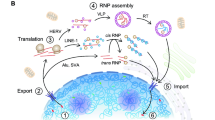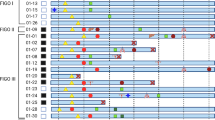Abstract
Background
Aberrant hypermethylation of specific genes is present in esophageal squamous cell carcinomas (ESCCs). Such hypermethylation is also present in normal-appearing esophageal mucosae of ESCC patients and is considered to contribute to the formation of a field for cancerization. On the other hand, the presence of global hypomethylation in ESCCs or in their background esophageal mucosae is unknown.
Method
We collected 184 samples of esophageal mucosae (95 normal mucosae from healthy subjects, and 89 non-cancerous background mucosae from ESCC patients) and 93 samples of ESCCs. Methylation levels of repetitive elements (Alu, LINE1) and cancer/testis antigen genes (NY-ESO-1, MAGE-C1) were measured by bisulfite pyrosequencing and quantitative methylation-specific PCR, respectively.
Results
Methylation levels of Alu, LINE1, NY-ESO-1, and MAGE-C1 were significantly lower in ESCCs than in their background and normal mucosae. Also, in the background mucosae, a significant decrease of the Alu methylation level compared with the normal mucosae was present. In ESCCs, methylation levels of the two repetitive elements and the two cancer/testis antigen genes were correlated with each other.
Conclusion
This is the first study to show the presence of global hypomethylation in ESCCs, and even in their non-cancerous background mucosae. Alu hypomethylation might reflect the severity of an epigenetic field for cancerization.


Similar content being viewed by others
Abbreviations
- ALDH2:
-
Acetaldehyde dehydrogenase 2
- LINE1:
-
Long interspersed nucleotide element 1
- PCR:
-
Polymerase chain reaction
- UICC:
-
Union for International Cancer Control
References
Shibata A, Matsuda T, Ajiki W, Sobue T (2008) Trend in incidence of adenocarcinoma of the esophagus in Japan, 1993–2001. Jpn J Clin Oncol 38:464–468
Lu CL, Lang HC, Luo JC, Liu CC, Lin HC, Chang FY, Lee SD (2009) Increasing trend of the incidence of esophageal squamous cell carcinoma, but not adenocarcinoma, in Taiwan. Cancer Causes Control 21:269–274
Hongo M, Nagasaki Y, Shoji T (2009) Epidemiology of esophageal cancer: orient to occident. Effects of chronology, geography and ethnicity. J Gastroenterol Hepatol 24:729–735
Pesko P, Rakic S, Milicevic M, Bulajic P, Gerzic Z (1994) Prevalence and clinicopathologic features of multiple squamous cell carcinoma of the esophagus. Cancer 73:2687–2690
Shimizu Y, Tukagoshi H, Fujita M, Hosokawa M, Kato M, Asaka M (2001) Metachronous squamous cell carcinoma of the esophagus arising after endoscopic mucosal resection. Gastrointest Endosc 54:190–194
Slaughter DP, Southwick HW, Smejkal W (1953) Field cancerization in oral stratified squamous epithelium; clinical implications of multicentric origin. Cancer 6:963–968
Ushijima T (2007) Epigenetic field for cancerization. J Biochem Mol Biol 40:142–150
Oka D, Yamashita S, Tomioka T, Nakanishi Y, Kato H, Kaminishi M, Ushijima T (2009) The presence of aberrant DNA methylation in noncancerous esophageal mucosae in association with smoking history: a target for risk diagnosis and prevention of esophageal cancers. Cancer 115:3412–3426
Lee YC, Wang HP, Wang CP, Ko JY, Lee JM, Chiu HM, Lin JT, Yamashita S, Oka D, Watanabe N et al (2011) Revisit of field cancerization in squamous cell carcinoma of upper aero digestive tract: better risk assessment with epigenetic markers. Cancer Prev Res 4:1982–1992
Xing EP, Nie Y, Song Y, Yang GY, Cai YC, Wang LD, Yang CS (1999) Mechanisms of inactivation of p14ARF, p15INK4b, and p16INK4a genes in human esophageal squamous cell carcinoma. Clin Cancer Res 5:2704–2713
Si HX, Tsao SW, Lam KY, Srivastava G, Liu Y, Wong YC, Shen ZY, Cheung AL (2001) E-cadherin expression is commonly downregulated by CpG island hypermethylation in esophageal carcinoma cells. Cancer Lett 173:71–78
Tanaka H, Shimada Y, Harada H, Shinoda M, Hatooka S, Imamura M, Ishizaki K (1998) Methylation of the 5′ CpG island of the FHIT gene is closely associated with transcriptional inactivation in esophageal squamous cell carcinomas. Cancer Res 58:3429–3434
Wong ML, Tao Q, Fu L, Wong KY, Qiu GH, Law FB, Tin PC, Cheung WL, Lee PY, Tang JC et al (2006) Aberrant promoter hypermethylation and silencing of the critical 3p21 tumour suppressor gene, RASSF1A, in Chinese oesophageal squamous cell carcinoma. Int J Oncol 28:767–773
Feinberg AP, Vogelstein B (1983) Hypomethylation distinguishes genes of some human cancers from their normal counterparts. Nature 301:89–92
Jones PA, Baylin SB (2007) The epigenomics of cancer. Cell 128:683–692
Ehrlich M (2002) DNA methylation in cancer: too much, but also too little. Oncogene 21:5400–5413
De Smet C, De Backer O, Faraoni I, Lurquin C, Brasseur F, Boon T (1996) The activation of human gene MAGE-1 in tumor cells is correlated with genome-wide demethylation. Proc Natl Acad Sci USA 93:7149–7153
Kaneda A, Tsukamoto T, Takamura-Enya T, Watanabe N, Kaminishi M, Sugimura T, Tatematsu M, Ushijima T (2004) Frequent hypomethylation in multiple promoter CpG islands is associated with global hypomethylation, but not with frequent promoter hypermethylation. Cancer Sci 95:58–64
Yang AS, Estecio MR, Doshi K, Kondo Y, Tajara EH, Issa JP (2004) A simple method for estimating global DNA methylation using bisulfite PCR of repetitive DNA elements. Nucleic Acids Res 32:e38
Weisenberger DJ, Campan M, Long TI, Kim M, Woods C, Fiala E, Ehrlich M, Laird PW (2005) Analysis of repetitive element DNA methylation by MethyLight. Nucleic Acids Res 33:6823–6836
Caballero OL, Chen YT (2009) Cancer/testis (CT) antigens: potential targets for immunotherapy. Cancer Sci 100:2014–2021
Gnjatic S, Nishikawa H, Jungbluth AA, Gure AO, Ritter G, Jager E, Knuth A, Chen YT, Old LJ (2006) NY-ESO-1: review of an immunogenic tumor antigen. Adv Cancer Res 95:1–30
Nuber N, Curioni-Fontecedro A, Matter C, Soldini D, Tiercy JM, von Boehmer L, Moch H, Dummer R, Knuth A, van den Broek M (2010) Fine analysis of spontaneous MAGE-C1/CT7-specific immunity in melanoma patients. Proc Natl Acad Sci USA 107:15187–15192
Chen RZ, Pettersson U, Beard C, Jackson-Grusby L, Jaenisch R (1998) DNA hypomethylation leads to elevated mutation rates. Nature 395:89–93
Eden A, Gaudet F, Waghmare A, Jaenisch R (2003) Chromosomal instability and tumors promoted by DNA hypomethylation. Science 300:455
Gaudet F, Hodgson JG, Eden A, Jackson-Grusby L, Dausman J, Gray JW, Leonhardt H, Jaenisch R (2003) Induction of tumors in mice by genomic hypomethylation. Science 300:489–492
Kaneda A, Kaminishi M, Sugimura T, Ushijima T (2004) Decreased expression of the seven ARP2/3 complex genes in human gastric cancers. Cancer Lett 212:203–210
Yoshida T, Yamashita S, Takamura-Enya T, Niwa T, Ando T, Enomoto S, Maekita T, Nakazawa K, Tatematsu M, Ichinose M et al (2011) Alu and Satalpha hypomethylation in Helicobacter pylori-infected gastric mucosae. Int J Cancer 128:33–39
Wilson AS, Power BE, Molloy PL (2007) DNA hypomethylation and human diseases. Biochim Biophys Acta 1775:138–162
Kim BH, Cho NY, Shin SH, Kwon HJ, Jang JJ, Kang GH (2009) CpG island hypermethylation and repetitive DNA hypomethylation in premalignant lesion of extrahepatic cholangiocarcinoma. Virchows Arch 455:343–351
Ogino S, Nosho K, Kirkner GJ, Kawasaki T, Chan AT, Schernhammer ES, Giovannucci EL, Fuchs CS (2008) A cohort study of tumoral LINE-1 hypomethylation and prognosis in colon cancer. J Natl Cancer Inst 100:1734–1738
Dewannieux M, Esnault C, Heidmann T (2003) LINE-mediated retrotransposition of marked Alu sequences. Nat Genet 35:41–48
Belancio VP, Hedges DJ, Deininger P (2008) Mammalian non-LTR retrotransposons: for better or worse, in sickness and in health. Genome Res 18:343–358
Bourc’his D, Bestor TH (2004) Meiotic catastrophe and retrotransposon reactivation in male germ cells lacking Dnmt3L. Nature 431:96–99
Guo ZS, Hong JA, Irvine KR, Chen GA, Spiess PJ, Liu Y, Zeng G, Wunderlich JR, Nguyen DM, Restifo NP et al (2006) De novo induction of a cancer/testis antigen by 5-aza-2′-deoxycytidine augments adoptive immunotherapy in a murine tumor model. Cancer Res 66:1105–1113
Oi S, Natsume A, Ito M, Kondo Y, Shimato S, Maeda Y, Saito K, Wakabayashi T (2009) Synergistic induction of NY-ESO-1 antigen expression by a novel histone deacetylase inhibitor, valproic acid, with 5-aza-2′-deoxycytidine in glioma cells. J Neurooncol 92:15–22
Acknowledgments
This study was supported by Grants-in-Aid for the National Cancer Center Research and Development Fund, and by the Project for Development of Innovative Research on Cancer Therapeutics (P-Direct) from the Ministry of Education, Culture, Science and Sport, Japan. Y. M. and K. G. are recipients of a Research Resident Fellowship from the Foundation for Promotion of Cancer Research.
Conflict of interest
The authors declare that they have no conflict of interest.
Author information
Authors and Affiliations
Corresponding author
Electronic supplementary material
Below is the link to the electronic supplementary material.
Rights and permissions
About this article
Cite this article
Matsuda, Y., Yamashita, S., Lee, YC. et al. Hypomethylation of Alu repetitive elements in esophageal mucosa, and its potential contribution to the epigenetic field for cancerization. Cancer Causes Control 23, 865–873 (2012). https://doi.org/10.1007/s10552-012-9955-4
Received:
Accepted:
Published:
Issue Date:
DOI: https://doi.org/10.1007/s10552-012-9955-4




